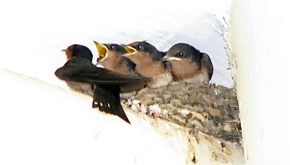“On the 14th April 2010 I noticed that a pair of Pacific Swallows (Hirundo tahitica) had built a nest above the sewerage pipe in a car park deck of my condo. There were two chicks in the nest. Feeding was practically non-stop during daytime, which shows that although we don’t see them, there are plenty of flying insects around (see video below).
“The two chicks fledged between 27th and 29th April. After fledging, they continued to roost for the night in the car park deck, on an electrical trunking nearby. They continued to be fed by the parents. After 7th May, they no longer returned to roost.
“On the 27th May, I noticed nesting activity on the same nest again. I do not know whether it was the same pair of Pacific Swallow or not. This time there were three chicks (left). The image quality may not show clearly the faeces outside the nest. These were deposited by the chicks, and perhaps by the parents also. I have seen one turned its body around, and with its vent outside the nest, raised the tail and dropped the faeces.
“They fledged between on 27th and 29th June. Unlike the previous one, this brood returned to the nest to roost for the night. They left permanently after 7th July.
“A video of the two cute chicks (the other one had already left the nest) perching at the edge of the nest is shown below.
“Using the dates of fledging as the basis, and if it was the same pair of Pacific Swallows recycling the nest, it can be concluded that they can reproduce with a cycle of two months.
“I am now monitoring to see if the nest will be recycled again.”
Sun Chong Hong
Singapore
4th August 2010









